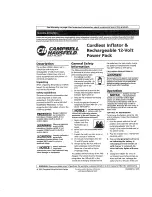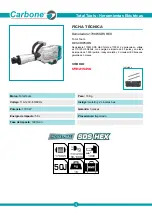
5712BT
3
rev. 11/05/14
1.
Pick a place in the shop for positioning of the press. Make sure there is adequate room around the operator, placement of the protection
shields and temporary storage for components to be pressed. The press area should not be in conflict with other machinery, production
areas, or restrict normal flow of shop activities during the work period. The floor should be clean and free from any obstacles or oil that
could cause the operator to slip.
2.
Since the shop press should be anchored, make sure the base of the press being mounted to is secure and provides adequate stability.
Use grade 8 hardware to secure press feet to installation base.
3.
Important – before anchoring press, make sure all press components are properly aligned and hardware is tightened. If the two vertical
side extrusions of the protector shield (optional) are not properly aligned, the shield will not slide up and down properly.
4.
Place press in vertical position (on head part of press), place press pin (#3) into the second hole of press leg (open end of press), left and
right side.
5.
Place press bed (#2) onto the pins (from open end of press), allowing press bed to rest on pins. Handles of the press bed must be on the
feet side of the press to ensure proper operation.
6.
Attach feet (#8) to right and left using (2) 3/8’’ bolts, 3/8 x 1 1/4’’ washer (#11) and 3/8’’ hex head nuts with lock washers, (#11), one on
each foot.
7.
Insert Z Bar leg (#9) between press legs. Attach Z bar to both right and left foot using remaining (2) 3/8 x 1 1/4’’ bolts, 3/8’’ washer (#11)
and 3/8’’ hex head nuts with lock washers,(#11).
8.
Stand press into upright position (feet on floor), allow press bed to rest on feet, remove press pins and position press bed into desired
height location, place press pins under press bed, allowing bed to rest on pins.
9.
Square up assembly making sure that the legs are not leaning in any direction and tighten bolts securely.
10. Place hydraulic unit on press carriage (#1) and position so that when the ram is extended, it will seat in the inside corner of the ram
position bracket.
11. Place press plates (#5) onto press bed.
12. Check all bolts for tightness and hydraulic unit for any leaks.
Note: Always use bearing shield when pressing bearings.
If press rocks
and is not level, loosen feet slightly to compensate, once level retighten bolts to ensure security.
OPERATING INSTRUCTIONS
This is the safety alert symbol used for the OPERATING INSTRUCTIONS section of this manual to alert you to potential
personal injury hazards. Obey all instructions to avoid possible injury or death.
1. Press operator and all observers must wear eye protection, protective clothing and shoes before operating the press.
2. Keep body parts out of work area during a pressing operation. Make sure all guards are properly adjusted and secured.
3. Consider the work to be accomplished and then determine:
a. The amount of ram stroke required to accomplish the job.
b. The correct punch or adapter to be used and then install on the ram.
c. The distance the ram should be from the component to be pressed and the required press bed height to support the component.
d. Any adapters used for pressing must have a maximum tonnage rating equal to or higher than the rated capacity of the press.
4. Raise the press bed to the required height by first removing the press bed pins. Once the pins are removed, raise or lower the press bed
to the required height. The holes in the press bed must align with the closest holes in the press frame uprights before the bed pins can be
installed. Make sure the press bed pins are fully engaged with the holes in the press bed or the channel flanges or back sides of the press
bed and the holes in the paralleled uprights on both sides of the press frame. DO NOT ATTEMPT ANY PRESS WORK WITHOUT FULL
ENGAGEMENT OF ALL PINS.
5. Prepare set up of the component to be pressed and appropriate adapters or fixtures to adequately support the component during the
pressing operation. Make sure set up is stable and secure, the ram force is straight, and parts being pressed cannot slip out or break. The
owner of the press must provide shielding that is practical and necessary for each application.
6. Position appropriate guarding (protective shield, protective blanket, etc.) between work setup and press operator.
7. Never attempt to raise or lower the press bed until the work piece and adaptors are removed from the bed.
8. Inspect the length of the bed lifting cables (if so equipped) every 3 months to make sure they are not frayed, worn, crushed or stretched.
Replace, adjust or repair before using press.
9. Air may become trapped in the hydraulic jack during shipping and/or handling. An air trapped jack will not pump up the required
incremental pump strokes or pumping may feel spongy. Follow these instructions to purge air from the jack's hydraulic system?
a. Turn the jack's release valve with the handle provided all the way in a clockwise direction until tight. Now turn the release valve two full
rotations in a counterclockwise direction.
b. Now put the pump handle in the pump handle receiver and activate the jack approximately 15 times.
c. Close the release valve by turning it clockwise until it stops. Pump the jack until the ram reaches maximum height.
d. Repeat steps "a" through "c" until all air is purged.
ASSEMbLy INSTRUCTIONS
5712BT - 12 TON BENCH TOP
HYDRAULIC SHOP PRESS























